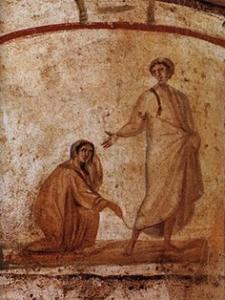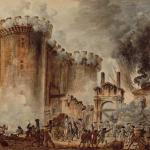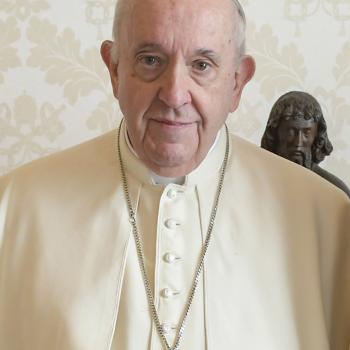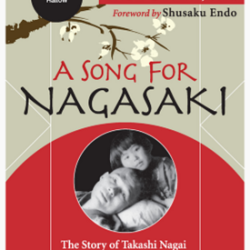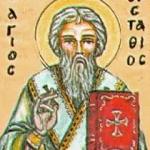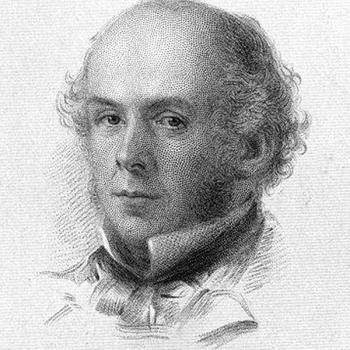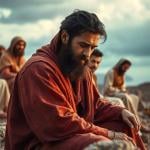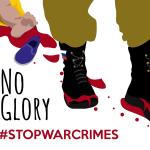Christ healing a bleeding woman, as depicted in the Catacombs of Marcellinus and Peter
Now there was a woman suffering from a haemorrhage for the
past twelve years, whom no one had been able to cure.
She came up behind him and touched the fringe of his cloak;
and the haemorrhage stopped at that very moment.
Jesus said, “Who was it that touched me?” When they all denied it,
Peter said, “Master, it is the crowds round you, pushing.”
But Jesus said, “Somebody touched me. I felt that power had gone out from me.”
Seeing herself discovered, the woman came forward trembling, and falling at his feet explained in front
of all the people why she had touched him and how she had been cured at that very moment.
“My daughter,” he said, “your faith has saved you; go in peace.”
— Luke 8: 42-48
When I heard this Gospel at Mass as a child, I asked my mother what it meant to have “an issue of blood.” I don’t remember her response, but I do remember wondering two things: how could someone bleed for twelve years and not die, and what form did this bleeding take? Open sores on her body? When my parents befriended a family whose sons were hemophiliacs, I thought maybe she had hemophilia. Older still, I decided it must be some sort of prolonged menstruation. Now, I realize that I am that woman, reaching out to touch the hem of Christ.
*********
“There’s no reason to be in pain. Ever,” the ER doctor chided me when I finally agreed to accept pain meds. It was late on the last Friday in Lent and, as I had explained, I had chosen not to take pain meds sooner in order to unite myself with the sufferings of Christ as a sacrifice.
Why was I back in the hospital? Those pesky fibroids (non-cancerous tumors; leiomyomas or myomas). I wrote in my January post about being hospitalized following an embolization to treat my prolonged bleeding and anemia. My 3-month follow-up MRI in March revealed that the procedure worked: the fibroids had died. It also revealed that a sizeable necrotic fibroid in the fundus had prolapsed into the lower quadrant of the uterine cavity, still attached to the uterine wall. When the pain intensified one Thursday morning, my gynecologist sent me to a colleague in the ER, anticipating that he would extract the necrotic tissue. But after examining me and the MRI report, the gynecological surgeon gave me unexpected news: removing the fibroid would put me at risk of bleeding out. He recommended a hysterectomy.
Just like that, I was back to where I had been in November when we first learned about my uterine fibroids. Even as I wept, I knew it was time. Two other gynecologists concurred.
Because it was not urgent, my husband drove me home. But the next day, Friday, when I began bleeding, I called the pastor of our Byzantine Catholic church so he could anoint me and hear my confession. Our children also wanted to confess, even my 5-year-old, who has not yet received the sacrament, so our priest spoke to him privately about good actions and bad actions and gave him a blessing and he came out of the church beaming. With our hearts joyful, we drove to the ER, which admitted me for observation pending my laparoscopic robot-assisted hysterectomy scheduled for Monday, Holy Monday. I would be giving up my uterus to be healthy and strong for my family.
Spending Holy Week carrying my cross alongside Christ, feeling pain in my body as we commemorated the pain he felt in his sacred body, was a profound spiritual experience. In the darkness of my hospital room during those five days and nights, it was often just Christ and me, suffering together. I found comfort holding my rosary and staring at the crucifix, keeping Christ’s love before my eyes. I would like to share some of my experience and reflections about the healing effect of suffering, which can draw us close enough to Christ to touch his garment.
******
The world tells us, as the ER doctor told me, that there’s never a good reason to be in pain. But faith, my faith, teaches that suffering can be meritorious, that if accepted lovingly, it can be purifying and uniting not only for us, but also for those around us. Shusaku Endo, Mark Wahlberg, my daughter, and St. Lucy helped remind me of this during Holy Week.
The joyful suffering of other Christians helps us embrace our own. Knowing that my body reacts to surgery with prolonged pain, I took Shusaku Endo’s Silence with me to the hospital. When I first read it in my Great Books Program in college more than twenty years ago, I was so spiritually disturbed that I sought out the program’s founder, Fr. Joseph Fessio, to talk out my distress. I pulled the book off my shelf before heading to the ER to keep my suffering in perspective – these Japanese Christians suffered for their faith, many of them tortured to death for Christ. I was not being tortured for my faith, nor was I likely to die. My pain would end. If these Christians could sing through their pain, I could certainly endure my pain with grace, cheerfulness, and gratitude. I could see the face of Christ in those around me, even if Sebastian Rodrigues could not. I saw Christ in my nurses, my doctors, my family, and my friends who visited; it did not matter whether they were believers, whether we agreed or disagreed politically, whether we chose to wear a mask or not (CA hospital protocol changed the day of my surgery, allowing children to visit and making masks optional). Christ is in every human being, and we are called to love as Christ loved.
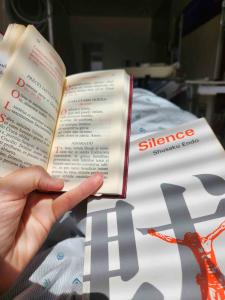
Praying and reading Silence in my “prayer corner” in the hospital room
My second reminder came one night in the hospital when, unable to sleep, I watched Mark Wahlberg’s “Father Stu” on my phone. Though I knew the basic premise about a boxer becoming a priest, I did not realize the amount of suffering the protagonist was called to endure, and the grace with which he accepted it, which brought grace to those around him. It reminded me of lines in St. Patrick’s Breastplate:
Christ in the heart of everyone who thinks of me
Christ in the mouth of everyone who speaks of me
Christ in the eye of everyone who sees me
Christ in every ear that hears me
We are called to witness to Christ at all times and in all places, to be Christ to others, because we never know who might be watching.
For example, our children. On the day of my surgery, my husband, sister-in-law, and children burst into my hospital room for a visit. When my nine-year-old daughter sat and hid her face in my side, I signaled to my husband to take the brothers on a walk. Alone, my daughter tearfully admitted that she had been smiling and acting happy since I came to the hospital, even though she was worried, because she did not want the brothers to worry. She knew, that as the oldest, the brothers imitated her, so she feigned happiness. What a beautiful, selfless act! She was worried, she told me, not that I might die, but because I might suffer. I hugged her and explained the powerful grace suffering can be, if only we accept it as such, and how I didn’t really mind the pain, because Christ was in it with me. How we respond to suffering can be a powerful witness to our children, to those we mentor, to anyone and everyone we encounter.
At 6am the morning of my surgery, I had a strange experience. It was almost as if my uterus, like a misbehaving child, was telling me that she would behave if I gave her another chance. I found myself thanking her for nurturing my four beautiful babies (one of whom is in heaven), and explaining that after 45 years together, we would have to part ways so that I could be healthy and strong for my family. Sacrificing my uterus – which is not what I wanted – for the greater good is insignificant in comparison to Christ sacrificing his very body for the greatest good, that we might have new life. Knowing that my small act was occurring in the shadow of Christ’s ultimate act, however, gave me peace. I do not think that the timing of my hysterectomy during Holy Week was accidental. God’s providence is usually more subtle, but he is always there.
Despite knowing how my body reacts to surgery, I was surprised to wake up from the anesthesia on Holy Monday already crying from the pain, which not even narcotics could eliminate. Having prepared my soul, however, God granted me the grace to embrace my pain as a beautiful gift from Christ, who was keeping me close to him, allowing me to suffer beside him during the holiest of weeks. As St. Thomas Aquinas observed, our prayers don’t change God; our prayers change us.
Yet even when we pray, even when we know God is with us, we can so easily derail, because we are human. Most women who receive a laparoscopic robot-assisted hysterectomy return home the same day, but not me. Someone told me about a friend who walked home a few hours after her surgery, and I laughed, knowing that would not be me. Still, when the surgeon decided not to release me Holy Wednesday morning because I had lost my dinner Holy Tuesday night, I struggled to accept that I might be in the hospital for the Holy Triduum. I prayed for the return of my peace and the words of a friend came to mind – when I had confessed to her my worry that my health would prevent me from celebrating Easter, after already missing Advent and Christmas because my uterus made me so sick, she encouraged me to imagine a different kind of Easter observation. And so, I accepted. A few hours later, the surgeon released me. I would be home for the Holy Triduum after all.
*****
Good Friday was my first full day with my children, who had been staying with my sister-in-law, but who had come home the previous night after attending Holy Thursday Mass, commemorating the institution of the Holy Eucharist, with my husband, while I watched online. The five of us spent Good Friday morning listening to Saints Alive Radio Theater on my Hallow prayer app. During the piece about early Christian martyr St. Lucy, which followed the Golden Legend, I suddenly hit pause. The narrator had just described Lucy’s mother as “suffering from a long, hemorrhagic illness,” a woman who “lived in chronic pain; her stomach would cramp, lightheadedness would overcome her, and she would grow faint.” I told my family I felt certain that Lucy’s mother suffered from anemia due to bleeding uterine fibroids, because this is how I felt last fall. This understanding united me across time and space with this early Christian woman, with all women who have suffered this same malady without cure, who had no option except to endure.
In the story, Lucy feels God asking her to take her ailing mother on a pilgrimage to the tomb of St. Agatha, a virgin martyr, beneath a volcano outside Sicily. During the clandestine Mass, Lucy and her mother hear the story of the bleeding woman from Luke. I hit pause again. My childhood question came to mind, and at last I knew the answer, because I had experienced it. I am that woman with the issue of blood. She is me.
Because of her faith, Lucy’s mother experiences physical healing, exclaiming to her daughter, “The pain is finally gone… I have been so blind, so selfish in my pain. I never wanted to give it to the Lord. I don’t deserve this. I don’t deserve to be healed.” Her physical healing leads to spiritual healing, allowing her, at last, to understand her daughter’s deep, persistent faith.
These women and I, we all reached out to touch the hem of Christ’s garment and he healed us. As Christ felt power leave him, I too felt a personal burden leave me when I reached out in faith one dark night in my hospital room. I returned home still in pain, but purified, joyful, grateful, free. Like St. Lucy’s mother, Christ granted me the grace to understand the faith of someone I loved. I had to lose an organ to become whole.
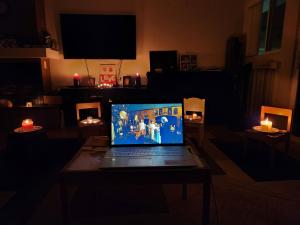
Watching Liturgy on Great and Holy Friday by candlelight at home with my youngest
That evening, my 5-year-old son and I turned out all the lights to watch Great and Holy Friday by candlelight, which my husband and older children attended. Through we are Roman Catholic, we often attend Divine Liturgy at the Byzantine Catholic church; I love the Eastern traditions during Great and Holy Week, in particular the beautiful 2.5-hour liturgy on Friday evening which includes an outdoor procession with the Plashchanitsa, or Christ’s Burial Shroud, in a ritual that is, in essence, Christ’s funeral.
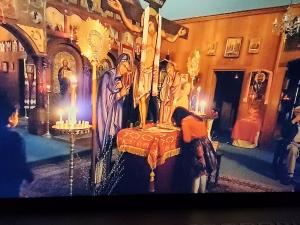
From my computer screen: my daughter venerating the Plashchanitsa (Christ’s Burial Shroud) on Great and Holy Friday as her brother looks on
On Saturday night both my boys stayed with me to watch Pascha, which my husband and daughter attended, a joyful 4-hour marathon celebration of the feast of feasts, the Resurrection of the Lord. The pain I felt in my body as we commemorated the pain in Christ’s body kept me close to him, rending it the most profoundly spiritual Holy Triduum I’ve experienced. Imagine a new kind of Holy Triduum, indeed.
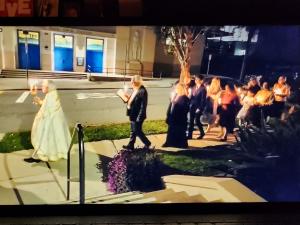 Pascha Procession around the church
Pascha Procession around the church
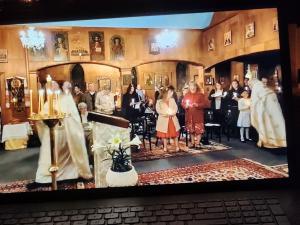
Per my husband: Fr. Alexei (in white vestments, right) taking advantage of a pause in the long Pascha Liturgy to ask my daughter how I am feeling
The following morning, I rose before dawn, pain-free. This was not a coincidence, and I was not really surprised. I had embraced my suffering during Holy Week and walked beside Christ in his passion and death, and he had taken away my pain with his Resurrection, allowing me to attend a sunrise Easter Mass with my family. What a powerful reminder that if we walk with Christ, if we are faithful, if we accept our crosses, he will one day take away all of our pain, forever, when we witness the Resurrection firsthand in heaven.
We are the body of Christ, members of the same unit. When one part of the body suffers, all parts of the body feel it, we all suffer. When one of us experiences joy or healing, we all do. This Easter season, let us be Christ to one another.
He is Risen! Indeed, he is risen!
(Traditional greeting and response in the Eastern church during Pascha)


